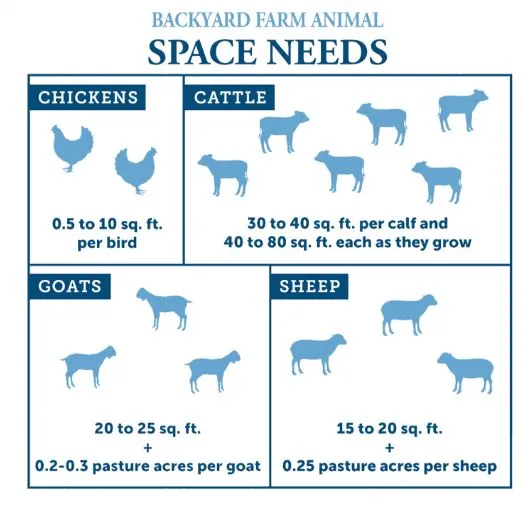Do you know the amount of space it takes to raise animals in the backyard or on small acreage? Here are few things you should be aware of when starting you own backyard, hobby, or new homestead.
I have often been asked what type of livestock would work best for others and their situation and how much space the animals would need. I recently received an article from Milk Products. It appeared in my e-mail and the article did a great job of giving answers to these questions.
No matter which types of species you select, make sure your local laws, subdivision rules and county ordinances allow for raising livestock on your property. Your choice of species can depend on your space and local laws.
Julian Olson, a veterinarian and also a technical services manager for Milk Products, says that many will start with a small flock of chickens. Still, he also brought up that individuals will also branch out into goats or cattle.
How much space is does it take to raise animals? Olson offers a few suggestions and facts on goats, chickens, sheep and cattle.

Source:(Milk Products)
Chickens
"If your going to buy chicks, you need give them their start in a controlled environment. With a dedicated enclosed brooder," Olson says. "You should have adequate temperature control, ventilation and a light in the brooder"
Here is some general space guidelines
• The Newly hatched chicks, need 1/2 a square foot of space each.
• Around 6 weeks old, provide 1 to 2 square feet of free space per bird.
• The Adult birds will require at least 4 sq. feet of indoor space and 5 to 10 square ft. of outdoor space for each bird.
•If you decide that you want to add more birds to your flock later. Remember you will need additional space.
Stress can take its toll on both adult birds and new chicks. Nutrition is important. Give a complete feed that is appropriate for your birds' age. I highly suggest that you supplement their diet with electrolytes and probiotics this will help provide them with needed energy and immunity support.
Goats
Gauging goat production
Backyard farmers and homesteaders often raise goats as an efficient source of meat or milk.
"Goats are very curious animals, make sure to have a strong fence around your outdoor area to keep goats in and predators away," Olson says. "If your breeding or milking your goats, you should have an enclosed area for milking or kidding." House goats of all ages should have a shed or barn with access to an outdoor area.
Here are the space guidelines for goats:
• Ideally, each goat should have at least 20 to 25 square feet of indoor space.
• Each goat should have 0.2 to 0.3 acres of pasture, with an exercise area of 50 square feet.
Sheep
Studying sheep needs
Just like goats, you can raise sheep in a shed or barn with access to an outdoor area. A south-facing, three-sided shed is often enough to protect them from the elements.
Here are space guidelines for sheep:
• They should each have 15 to 20 square feet in a shed.
• Access to pasture. "Sheep are grazers," Olson says. "If you plan to raise a flock, adequate pasture is essential. Pastures can include a mixture of grasses, legumes, brush and trees."
• Generally, 4 sheep per acre is the rule of thumb.
Cattle
Caring for cattle
If you are considering raising some calves, it takes up the most space and is recommended for people who have experience raising small livestock.
Here is what Olson recommends for space when raising cattle:
• A calf housed in a barn or shed will need 30 to 40 square feet of space.
• After the calves are weaned and continue to grow, their space requirements will increase. It all depends the length of time that you plan on raising them, they could need from 40 to 80 square feet each.
Most backyard, hobby farmers and new homesteaders purchase calves born on another farm. If this is your situation, Olson says to be sure to have a high-quality milk replacer on hand to support optimal calf growth and health. It's highly recommended to have a milk replacer that contains 20% protein and 20% fat, this should be enough to provide nutrition if fed according to the directions on the packaged bag or the tag.
I would recommend no matter what choice of animal, consider visiting with other farmers in your area, along with the local feed store, and county extension agent, before diving into backyard, hobby or small farming. The raising of animals has more responsibilities than having the space. You have to consider the time and work involved to provide nutrition, maintain animal health, and provide a clean and save environment.
Raising an animal can be a great opportunity to learn how dedicated the farmers and ranchers are to producing safe, affordable food for all of us.

